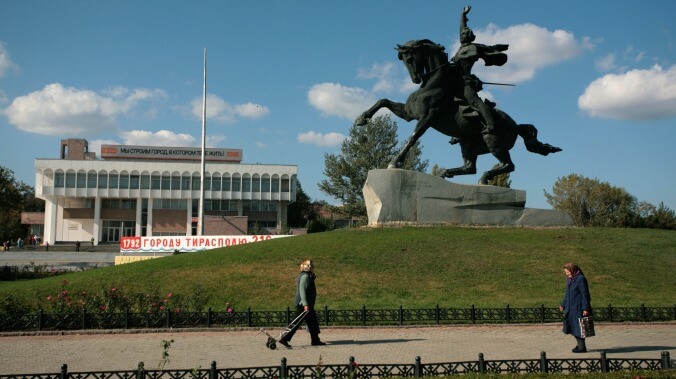Women pass the statue of Alexander Suvorov, the founder of Tiraspol in the Transnistria region in Moldova. Photo: Matthias Schumann
We explore some of Wikipedia’s oddities in our 6,128,221-week series, Wiki Wormhole.
This week’s entry: Transnistria
What it’s about: The Pridnestrovian Moldavian Republic, unofficially known as Transnistria, a country about which many things are unofficial. When the Soviet Union dissolved in 1992, Moldova—a country of 13,000 square miles between Ukraine and Romania—became independent for the first time since 1538, having been part of the Ottoman Empire, Russian Empire, Romania, and the USSR. As Moldova broke away from the USSR, Transnistria—a 1,600-square-mile strip of land running along the Moldovan-Ukrainian border—tried to break away from Moldova. Russia stepped in and created a power-sharing agreement and Moldovan independence remains unresolved to this day.
Biggest controversy: Transnistria has spent nearly 30 years in legal limbo. After a 1990-92 war for independence ended in a ceasefire, the breakaway republic became a “autonomous territorial unit with special legal status,” within Moldova. Which means Transnistria is largely autonomous, with its own government, military, postal system, currency, constitution, flag, and national anthem. But it’s only officially recognized as an independent country by three other unrecognized former Soviet territories—Abkhazia (officially part of Georgia), South Ossetia (also Georgia), and Artsakh (Azerbaijan)—who together form the Community For Democracy And Rights Of Nations, also known as the Commonwealth Of Unrecognized States, a decidedly uninspiring superhero team-up if we’ve ever heard one.
Strangest fact: Transnistria is the only remaining country with the old Soviet hammer-and-sickle logo on its flag, although it’s not a communist country in either the political or economic sense. The country is a semi-presidential republic, a system in which a popularly elected president and prime minister chosen from the legislature share power. (This is distinct from parliamentary republics like Ireland or India, where the prime minister is the chief executive and the president is largely ceremonial.) Post-Soviet Transnistria privatized its economy, and depending on who you ask, that economy is based on steel, energy, and textiles, or on contraband and gunrunning—which the Transnistrian government denies. In 2005 EU officials dismissed arms trafficking claims as Moldova’s attempt to discredited Transnistria’s government, although the UN also decried “historically low levels of transparency.”
Thing we were happiest to learn: Transnistria’s second-largest city is named Bender, so feel free to make plenty of, “I’ll get my own country! With blackjack! And hookers!” jokes in the comments. Beyond that, despite its fraught position in the world, and sustained tension with Moldova, Ukraine, and Russia for various reasons, internally, Transnistria seems to be a model of tolerance. There’s no mention of strife between the ethnic Moldovans, Russians, and Ukrainians that populate the country in roughly equal thirds, and while the country is 91% Orthodox Christian, the country guarantees freedom of religion and 114 different faiths are practiced within its borders (although in 2007 Pat Robertson’s Christian Broadcasting Network claims Protestants were being persecuted in Transnistria, Wikipedia provides nothing to back up those claims). That said, the country has been criticized for limiting freedom of speech, press, and assembly, not that any of those things are exactly having a banner year in this country.
Thing we were unhappiest to learn: About that sustained tension with Russia. After the semi-successful war for independence in 1992, Russia left a peace-keeping force in Transnistria, and they never left. (Former Soviet troops withdrew from the rest of Moldova shortly after the breakup of the USSR.) By 1994, Russia and Moldova signed a treaty that stated the Russian troops would leave the country within three years, but the Russian Duma refused to ratify it. While Russia spent the subsequent decade removing Soviet military hardware from Moldova, the troops remain.
Best link to elsewhere on Wikipedia: While Transnistria still doesn’t have full recognition as an independent country, it has gotten much further than many other active separatist movements in Europe. Virtually every country has some group that wants to break away, from the Basque in France and Spain, to Sardinians who want their island to separate from Italy, to every region in Belgium, to the French-speaking Jurassiens in Switzerland (which leads to the wonderfully titled Jurassic separatism page). Brexit is clearly part of a larger separatism trend in the U.K., which has secessionist movements going in each of the U.K.’s member nations (England, Scotland, Wales, Northern Ireland), as well as Cornwall (England’s Southwesternmost county), Mercia (a big chunk of central England), Wessex (the south of England), Yorkshire (the northeasternmost counties that don’t border Scotland), and the 221-square-mile Isle Of Man (population 83,314).
Further down the Wormhole: Another country that’s struggled with international recognition is North Korea. (Both Pyongyang and Seoul claim to be the legitimate government of Korea as a whole; unsurprisingly, most countries around the world support the South’s claim.) While North Korea has done much to alienate itself from its neighbors, they still share unifying cultural elements, like the iconic East Asian hip-and-gable roof, in which both sides of the roof are curved inwards, as opposed to the straight, inverted-V style of Western roofs. The hip-and-gable roof is also a key element in Japanese architecture, as are Toilets in Japan, whose often-high-tech conveniences are distinctive enough to merit their own Wikipedia page. Also specific to Japan and toilets yet also universal is the Mariko Aoki phenomenon, which is what the Japanese call the urge to poop that strikes the moment you enter a bookstore. We’ll examine this strange occurrence and the unfortunate woman whose name is forever associated with it next week.




























![Rob Reiner's son booked for murder amid homicide investigation [Updated]](https://img.pastemagazine.com/wp-content/avuploads/2025/12/15131025/MixCollage-15-Dec-2025-01-10-PM-9121.jpg)












